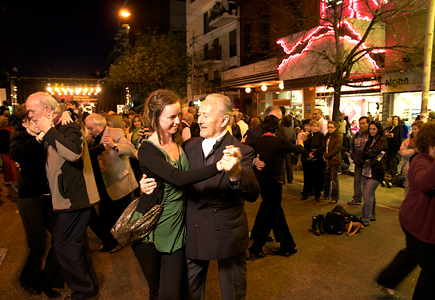Source: National Geographic Traveler
By: Wayne Bernhardson
03.31.2010

Perhaps you've heard the clichés declaring Buenos Aires the "Paris of the South" and "the birthplace of tango." After 29 years of visiting the city, I've decided these descriptions lock Argentina's capital into a straitjacket. Its Francophile side is only one aspect of a municipality that the late, great Argentine writer Jorge Luis Borges pronounced "as eternal as water and air." In just the time I've known it, this resilient conurbation has endured a brutal dictatorship, enjoyed a return to democracy, and experienced a boom-bust-boom renaissance that has made it one of South America's top destinations.
A backwater in colonial times, Buenos Aires pinned its hopes on silver, but its real wealth came from cattle herds grazing the nearby Pampas. The city has been shaped by immigrants—many from Italy and Spain—who helped create a metropolis of almost three million porteños (as residents of Buenos Aires call themselves), with another ten million beyond the beltway. Its many barrios, or neighborhoods, boast an even greater diversity, including a Chinatown and areas built by recent immigrants from other South American nations.
These influxes helped create a city with a famously vigorous streetlife. Often, it seems, porteños are pouring onto the plazas for political protests, even as parents push their young children on playground swings past midnight. I regularly see culture hounds queuing at museums, diners filling some of the continent's most innovative restaurants, and chic women trolling fashion-forward clothiers.
More than the Paris of the South, Buenos Aires is a New World hybrid that combines the political intensity of Washington, D.C., with a Manhattanite mixture of culture and sights, restaurants, shopping, one-of-a-kind accommodations, and a frenetic nightlife that makes New York look like a city that naps. When I first visited Buenos Aires, in 1981, I was a grad student crashing at his future in-laws' apartment; today Buenos Aires is my second home. Still, the city dishes up something new each time I step outside my door.
It takes full-time residence here to know what will appear around the corner at any given moment. So it is to full-time—and longtime—residents that I turn in my pursuit of the essence of Buenos Aires. I begin with Exhibit A: food.
(click the link below for more)
OUR MENTION:
Across town in the Palermo and Recoleta quarters sit two small hotels in historic buildings: the friendly, modestly priced Miravida Soho, in a restored 1930s mansion; and the new, luxe Algodon Mansion, a boutique inn fitted into a 1912 French Classical residence. Also in Palermo is the 1555 Malabia House, the city's first B&B, which offers another BA experience: It occupies a 19th-century convent that, manager Romina Giunta tells us, preserves its original configuration. "The renovation had to adapt to the residence to maintain its historical features," including 15-foot-high ceilings and such original details as marble staircases. "The baths were once nuns' kitchens," Giunta points out. But the Malabia feels nothing like a convent, with its trompe l'oeil murals, lustrous wood floors, and plush bedding. Like other hostelries in this new-old city, the Malabia is an older structure recast—a far cry from the flophouses I remember.
External Link: Click here for the full article.